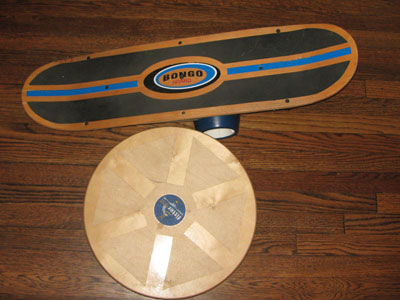| 283 | Hiking Skills - Balance | 2010-09-20 |

While leading a backpacking trip of inexperienced hikers, one of the backpackers was definitely having difficulties. She was so much slower than the other hikers that it caused group management problems. We took weight from her pack so that she was carrying basically an empty Kelty frame pack. She still was very slow. She was slow going uphill and slow going downhill. She was even slow on the flats. She was just slow moving. Something was wrong.
After walking with her for hours I saw that she was having difficulty with the uneven tread of the trail. There were rock, roots, and other tripping hazards. Early on the hike she had fallen a couple of times and now she said that she was walking defensively. I found some appropriately sized sticks to use as walking aids (pre-trekking pole days). She didn't like the sticks; but used them.
We finally arrived at camp hours behind the rest of the group. It was there she exclaimed, "I can walk really fast and all day long - on the level floors of the mall." I didn't doubt her one bit. She was out of balance on the trail.
Balance
Being in balance is an important skill for hiking. Balance is the ability to adjust your center of gravity for the terrain you are covering and the weight you are carrying (in your pack). When crossing a creek on a slick log, balance (or the lack of balance) is obvious; but when just hiking, balance seems less obvious. Your subconscious is always working to attain a balanced posture. It is you internal gyroscope, your equilibrium working to keep you erect. Your muscles are adjusting and re-adjusting to maintain balance. If you are out of balance, your muscles will work even harder and you will never feel comfortable.
A few balance improvement hints ...
- Build up your core muscle group. The core muscles are always adjusting to help achieve balance.
- Hike on varied surfaces. Get off the sidewalk or paved paths and walk on a trail. Moving over rocks, roots, logs, etc will help your balance.
- Walk in the dark. Walking at night helps your balance. Your visual perception is limited forcing your body to react even quicker to the subtle changes of movement.
- Use specialty equipment such as a wobble board or bongo board. The wobble board allows you to stand on a circular board which pivots in the middle in all directions. The bongo board is a skateboard looking plank attached to a rolling pivot point. Both boards work your core muscles and equilibrium.
- Make your own balance beams. While on your walk, intentionally walk on a curb or along a fallen log. Lay a two-by-four on the ground and walk it. Walk a four inch (or greater) in diameter piece of PVC pipe. Remember, it will roll.
- Once you are more comfortable balancing, add a pack while performing your drills.
- Trekking sticks will help keep you from falling, but might not actually improve your balance. They will help you gain confidence moving over mixed terrain; but they might not improve your balance.
- Apply the first Hiking Skill - Mileage. Putting in the miles will help you find your balance.
If you are having unexplained trouble with keeping an appropriate speed it might be your balance. Your body might be working twice as hard at each step, because it is fighting to find that correct posture of balance.
Next week we will discuss pace.
Happy balanced trails.
